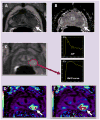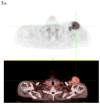Oncologic Angiogenesis Imaging in the clinic---how and why
- PMID: 22132017
- PMCID: PMC3224985
- DOI: 10.2217/iim.11.31
Oncologic Angiogenesis Imaging in the clinic---how and why
Abstract
The ability to control the growth of new blood vessels would be an extraordinary therapeutic tool for many disease processes. Too often, the promises of discoveries in the basic science arena fail to translate to clinical success. While several anti angiogenic therapeutics are now FDA approved, the envisioned clinical benefits have yet to be seen. The ability to clinically non-invasively image angiogenesis would potentially be used to identify patients who may benefit from anti-angiogenic treatments, prognostication/risk stratification and therapy monitoring. This article reviews the current and future prospects of implementing angiogenesis imaging in the clinic.
Figures






Similar articles
-
Therapeutic application of anti-angiogenic nanomaterials in cancers.Nanoscale. 2016 Jul 7;8(25):12444-70. doi: 10.1039/c5nr07887c. Epub 2016 Apr 12. Nanoscale. 2016. PMID: 27067119 Review.
-
Following up tumour angiogenesis: from the basic laboratory to the clinic.Clin Transl Oncol. 2008 Aug;10(8):468-77. doi: 10.1007/s12094-008-0235-4. Clin Transl Oncol. 2008. PMID: 18667377 Review.
-
Broad targeting of angiogenesis for cancer prevention and therapy.Semin Cancer Biol. 2015 Dec;35 Suppl(Suppl):S224-S243. doi: 10.1016/j.semcancer.2015.01.001. Epub 2015 Jan 16. Semin Cancer Biol. 2015. PMID: 25600295 Free PMC article. Review.
-
Vesicoureteral Reflux.2024 Apr 30. In: StatPearls [Internet]. Treasure Island (FL): StatPearls Publishing; 2025 Jan–. 2024 Apr 30. In: StatPearls [Internet]. Treasure Island (FL): StatPearls Publishing; 2025 Jan–. PMID: 33085409 Free Books & Documents.
-
Preclinical molecular imaging of tumor angiogenesis.Q J Nucl Med Mol Imaging. 2010 Jun;54(3):291-308. Q J Nucl Med Mol Imaging. 2010. PMID: 20639815 Free PMC article. Review.
Cited by
-
Combined prognostic value of the SUVmax derived from FDG-PET and the lymphocyte-monocyte ratio in patients with stage IIIB-IV non-small cell lung cancer receiving chemotherapy.BMC Cancer. 2021 Jan 14;21(1):66. doi: 10.1186/s12885-021-07784-x. BMC Cancer. 2021. PMID: 33446134 Free PMC article.
-
First-In-Human Study Demonstrating Tumor-Angiogenesis by PET/CT Imaging with (68)Ga-NODAGA-THERANOST, a High-Affinity Peptidomimetic for αvβ3 Integrin Receptor Targeting.Cancer Biother Radiopharm. 2015 May;30(4):152-9. doi: 10.1089/cbr.2014.1747. Cancer Biother Radiopharm. 2015. PMID: 25945808 Free PMC article.
-
Immuno-PET imaging of tumor endothelial marker 8 (TEM8).Mol Pharm. 2014 Nov 3;11(11):3996-4006. doi: 10.1021/mp500056d. Epub 2014 Jul 11. Mol Pharm. 2014. PMID: 24984190 Free PMC article.
-
The Distribution Volume of 18F-Albumin as a Potential Biomarker of Antiangiogenic Treatment Efficacy.Cancer Biother Radiopharm. 2019 May;34(4):238-244. doi: 10.1089/cbr.2018.2656. Epub 2019 Feb 15. Cancer Biother Radiopharm. 2019. PMID: 30767667 Free PMC article.
-
In vivo imaging of therapy-induced anti-cancer immune responses in humans.Cell Mol Life Sci. 2013 Jul;70(13):2237-57. doi: 10.1007/s00018-012-1159-2. Epub 2012 Oct 5. Cell Mol Life Sci. 2013. PMID: 23052208 Free PMC article. Review.
References
-
- Folkman J. Tumor angiogenesis: Therapeutic implications. NEJM. 1971 November 18;282(21):1182–1186. - PubMed
-
- Black WC, Welch HG. Advances in diagnostic imaging and overestimations of disease prevalence and the benefits of therapy. N Engl J Med. 1993 Apr 29;328(17):1237–1243. - PubMed
-
- Naumov GN, Akslen LA, Folkman J. Role of angiogenesis in human tumor dormancy: animal models of the angiogenic switch. Cell Cycle. 2006 Aug;5(16):1779–1787. - PubMed
-
- Folkman J. Angiogenesis. Annu Rev Med. 2006;57:1–18. - PubMed
-
- Udagawa T, Fernandez A, Achilles EG, Folkman J, D’Amato RJ. Persistence of microscopic human cancers in mice: alterations in the angiogenic balance accompanies loss of tumor dormancy. FASEB J. 2002 Sep;16(11):1361–1370. - PubMed
Grants and funding
LinkOut - more resources
Full Text Sources
